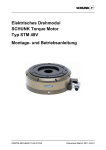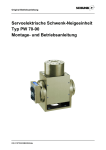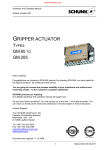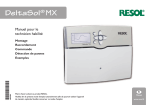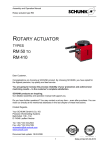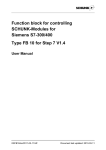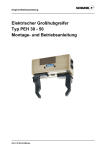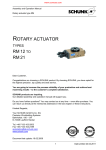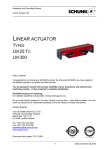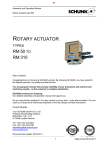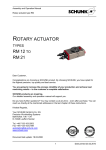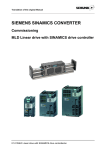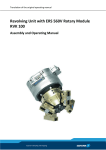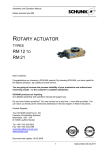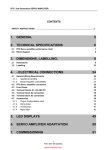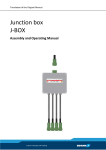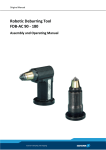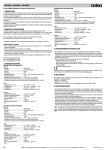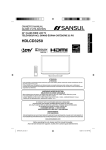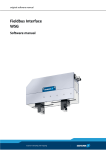Download User Manual
Transcript
www.comoso.com Translation of the original manual Servo-electric rotary pan-tilt actuator Type PW 70-90 Assembly and operating manual 02.01/PW/0389353/en www.comoso.com Translation of the original manual Imprint: Copyright: This manual remains the copyrighted property of SCHUNK GmbH & Co. KG. It is solely supplied to our customers and operators of our products and forms part of the unit. This documentation may not be duplicated or made accessible to third parties, in particular competitive companies, without our prior permission. Technical changes: We reserve the right to make alterations for the purpose of technical improvement. Document number: 0389353 Edition: 02.01 / 14.08.2012 / en © SCHUNK GmbH & Co. KG, Lauffen/Neckar All rights reserved Dear Customer, Congratulations on choosing a SCHUNK product. By choosing SCHUNK, you have opted for the highest precision, top quality and best service. You are going to increase the process reliability of your production and achieve best machining results – to the customer's complete satisfaction. SCHUNK products are inspiring. Our detailed assembly and operation manual will support you. Do you have further questions? You may contact us at any time – even after purchase. You can reach us directly at the mentioned addresses in the last chapter of these instructions. Kindest Regards, Your SCHUNK GmbH & Co. KG Precision Workholding Systems Bahnhofstr. 106 – 134 D-74348 Lauffen/Neckar Tel. +49-7133-103-2503 Fax +49-7133-103-2189 [email protected] www.schunk.com 2 02.01/PW/0389353/en www.comoso.com Table of contents Table of contents 1 2 About this manual................................................................................................. 5 1.1 Purpose/validity .......................................................................................... 5 1.2 Target groups ............................................................................................. 5 1.3 Applicable documents ................................................................................ 5 1.4 Symbols in this manual .............................................................................. 6 1.5 Terms used in this manual ......................................................................... 6 Basic safety notes ................................................................................................ 7 2.1 Intended use .............................................................................................. 7 2.2 Environmental and operating conditions .................................................... 7 2.3 Controlled production ................................................................................. 7 2.3.1 Condition of the inputs/ outputs (I/O) ............................................. 8 2.3.2 Protective equipment ..................................................................... 8 2.3.3 Constructional changes, attachments or modifications .................. 8 2.3.4 Special standards .......................................................................... 8 2.4 Personnel qualification ............................................................................... 9 2.5 Safety-conscious working........................................................................... 9 2.6 Notes on particular risks ........................................................................... 10 3 Warranty .............................................................................................................. 11 4 Scope of delivery ................................................................................................ 11 5 Accessories ......................................................................................................... 12 5.1 6 7 8 Connecting elements ............................................................................... 12 Technical Data .................................................................................................... 13 6.1 Basic data ................................................................................................ 13 6.2 Factory settings / DEFAULT Value .......................................................... 14 6.3 Power supply requirements ...................................................................... 14 Description of the module .................................................................................. 15 7.1 Structure................................................................................................... 15 7.2 Functional principle .................................................................................. 16 7.3 Connection cap board .............................................................................. 17 Assembly and commissioning .......................................................................... 18 8.1 Mechanical Connection ............................................................................ 18 02.01/PW/0389353/en 3 www.comoso.com Table of contents 8.2 Example of mounting ............................................................................... 19 8.3 Electrical connection ................................................................................ 19 8.4 9 10 11 4 8.3.1 EMV-fitting ................................................................................... 20 8.3.2 RS232 interface ........................................................................... 23 8.3.3 CAN interface .............................................................................. 25 8.3.4 Interface Profibus DP .................................................................. 28 8.3.5 DEFAULT and BOOT function..................................................... 30 System integration ................................................................................... 32 8.4.1 System structure.......................................................................... 32 8.4.2 SCHUNK Motion protocol ............................................................ 32 8.4.3 Most important commands .......................................................... 33 Troubleshooting.................................................................................................. 38 9.1 Module does not move ............................................................................. 38 9.2 The module is sluggish or jerky ................................................................ 38 9.3 The module's motor is not turning ............................................................ 38 9.4 Module stops abruptly .............................................................................. 38 Maintenance and care ........................................................................................ 39 10.1 Maintenance intervals .............................................................................. 39 10.2 Dismantling the module ............................................................................ 39 EC declaration of incorporation ........................................................................ 40 02.01/PW/0389353/en www.comoso.com About this manual 1 1.1 About this manual Purpose/validity This manual is part of the module and describes the safe and proper use during all phases of operation. This manual is valid only for the module specified on the front page. 1.2 Target groups Target group Task Manufacturer, operator Keep this manual available for the personnel at all times. Require personnel to read and observe this manual and the applicable documents, especially the safety notes and warnings. Skilled personnel, fitter Read, observe and follow this manual and the applicable documents, especially the safety notes and warnings. Table 1 1.3 Applicable documents You can find the following documents on our homepage: Document Purpose Catalog Technical data or application parameters of the module and information on accessories. The last version is always valid. Software manual (MotionControl.pdf) More detailed information about the parameters and special features of the individual bus systems. General terms of bussiness Including notes on the warranty. Table 2 02.01/PW/0389353/en 5 www.comoso.com About this manual 1.4 Symbols in this manual To give you quick access to information, the following symbols will be used in this guide: Symbol Designation Dangers for persons. DANGER Nonobservance causes death or serious injuries. Dangers for persons. WARNING Nonobservance can cause death or serious injuries. NOTICE Information on avoiding material damage, for explanation or to optimize the work processes. Prerequisite for a handling instruction. Handling instruction, also measures in a warning or note. 1. Step-by-step handling instruction. 2. Observe the order. 3. ... Component/spare part represented in a graphic. Part/detail shown in a graphic which is part of a spare part or which must be provided by the customer. (10), (/10/) Reference in the text or in a handling instruction to a part that is represented in a graphic. Master M Slave S Parameter will be transferred from Master M to Slave S Table 3 1.5 Terms used in this manual Term Meaning Cycle A cycle includes the following movement: One rotating motion (1x to specified position and 1x back to initial position) Table 4 6 02.01/PW/0389353/en www.comoso.com Basic safety notes 2 2.1 Basic safety notes Intended use This module has been designed for pivoting and turning workpieces or other objects. The module is intended for installation in a machine. The requirements of the applicable guidelines must be observed and complied with. The module may be used only in the context of its defined application parameters. Any other use or use exceeding that specified is an infringement of use for intended purpose. The manufacturer bears no liability for damage resulting from such use. 2.2 Environmental and operating conditions The module may be used only in the context of its defined application parameters (see chapter 6, page 13 and catalog). Make sure that the environment is clean and the ambient temperature corresponds to the specifications per the catalog. Maintenance intervals. (see chapter 10.1, page 39) Make sure that the environment is free from splash water and vapors as well as from abrasion or processing dust. Excepted are modules that are designed specially for contaminated environments. 2.3 Controlled production The module represents the state of the art and the recognized safety rules at the time of delivery. However, it can present risks if, for example: • The module is not used in accordance with its intended purpose. • The module is not installed or maintained properly. 02.01/PW/0389353/en 7 www.comoso.com Basic safety notes • 2.3.1 The EC Machinery Directive, the VDE directives, the safety and accident-prevention regulations valid at the usage site, or the safety and installation notes are not observed. Condition of the inputs/ outputs (I/O) During the run-up of the module not defined I/O conditions may occur. Do not allow a direct connection with actuators. 2.3.2 Protective equipment Provide protective equipment per EC Machinery Directive. 2.3.3 Constructional changes, attachments or modifications Additional drill holes, threads, or attachments that are not offered as accessories by SCHUNK may be attached only with permission of SCHUNK. 2.3.4 Special standards The following harmonized standards were adhered to: • Industrial scientific and medical (ISM) radio-frequency equipment - Electromagnetic disturbance characteristics - Limits and methods of measurement (IEC/CISPR 11:2003 + A1:2004, modified + A2:2006); German version EN 55011:2007 + A2:2007 class A (this is equivalent to EN 61000-6-4:2004) • Electromagnetic compatibility (EMC) - Part 6-2: Generic standards - Immunity for industrial environments (IEC 61000-6-2:2005); German version EN 61000-62:2005 8 02.01/PW/0389353/en www.comoso.com Basic safety notes 2.4 Personnel qualification The assembly, initial commissioning, maintenance, and repair of the module may be performed only by trained specialist personnel. The assembly, initial commissioning, maintenance, and repair of the module may be performed only by trained specialist personnel. Every person called upon by the operator to work on the module must have read and understood the complete Assembly and Operating Manual, especially chapter 2 "Basic safety notes". This applies particularly to occasional personnel such as maintenance personnel. 2.5 Safety-conscious working Avoid any manner of working that may interfere with the function and operational safety of the module. Observe the safety and accident-prevention regulations valid at the usage site. 02.01/PW/0389353/en 9 www.comoso.com Basic safety notes 2.6 Notes on particular risks Risk of injury from objects falling and being ejected! Provide protective equipment to prevent objects from falling or being ejected, such as processed workpieces, tools, chips, fragments, rejects. Risk of injury when the machine/system moves unexpectedly! Do not move parts by hand when the energy supply is connected. Do not reach into the open mechanism or the movement area of the module. Remove the energy supplies before installation, modification, maintenance, or adjustment work. Perform maintenance, modifications, and additions outside the danger zone. For all work, secure the module against accidental operation. 10 02.01/PW/0389353/en www.comoso.com Warranty 3 Warranty The warranty is valid for 24 months from the delivery date to the production facility under the following conditions: • Intended use in 1-shift operation • Observation of the maintenance intervals (see chapter 10.1, page 39) • Observation of the ambient conditions and operating conditions (see chapter 2.2, page 7) Parts touching the workpiece are not part of the warranty. Also observe our general terms of business. 4 Scope of delivery The scope of delivery includes: • Servo-electric rotary pan-tilt actuator Type PW in the version ordered • USB to RS232 converter inclusive driver CD • DVD Content of DVD: • MCDemo (configuration and commissioning tool) • Operating manual in PDF format • MotionControl software manual in PDF format Note The module is delivered without connection cap ASK. It can be ordered separately as accessory. Connection cap ASK is necessary for operation. The following accessories are available for the module: • Connecting elements (PAM) • Hybrid cable • Connection cables Order accessories separately. For additional accessories, see catalog. 02.01/PW/0389353/en 11 www.comoso.com Accessories Notes Older versions require the PowerConfig tool from the DVD for flashing. If older versions are to be used, contact your SCHUNK representative. 5 5.1 Accessories Connecting elements See catalog for exact type designations of compatible connecting elements. /2/ /1/ /3/ /4/ /1/ straight /2/ conical /3/ right-angle /4/ adapter plate Figure 1 12 02.01/PW/0389353/en www.comoso.com Technical Data 6 6.1 Technical Data Basic data Further technical data can be found in our catalog The most recent version applies. Mechanical operating data Axis 1 Axis 2 Electrical operating data Electronic control unit Size 70 90 Mass [kg] Noise emission [dB(A)] IP rating (when using DMI-connection cap) 1,8 ≤ 70 54 3,4 ≤ 70 54 Ambient temperature [°C] Min. Max. Rated torque [Nm] Peak torque [Nm] Angle of rotation [°] Max. acceleration [°/s²] Max. angular velocity [°/s] Rated torque [Nm] Peak torque [Nm] Angle of rotation [°] Max. acceleration [°/s²] Max. angular velocity [°/s] Rated voltage [V DC] +5 +55 12,0 24,0 ±120 960 240 2,0 4,0 >360 1440 360 24 +5 +55 23,0 46,0 ±120 600 150 12,0 24,0 >360 960 240 24 Rated current [A] 4 4 Max. current [A] 8 8 Interface RS232 CAN Profibus, DP Power supply [V DC] Rated current [A] Sensor system X X X 24 0,5 Encoder X X X 24 0,5 Encoder Table 5 02.01/PW/0389353/en 13 www.comoso.com Technical Data 6.2 Factory settings / DEFAULT Value Reference Interface Data rate Module address Axis 1 RS232 9600 13 Axis 2 RS232 9600 14 Table 6 6.3 Power supply requirements Designation Output power supply (motor) Power supply for logic Value 24 V DC 24 V DC +10% / -4%; Residual ripple < 150mVSS; Switching peak < 240mVSS Connection value Number of modules x Rated module current x 1,2 Table 7 14 02.01/PW/0389353/en www.comoso.com Description of the module 7 7.1 Description of the module Structure /1/ /4/ /2/ /5/ /3/ /1/ Axis 2 (swivel axis) /2/ Axis 1 (tilt axis) /3/ Base plate with four fixing bores /4/ Assembly interface for attachments /5/ Connection cap with blind plug M16x1.5 and metric cable fitting for EMC connection Figure 2 Servo-electric rotary pan-tilt actuator Note Only tilt axis (Axis 1) can be controlled via DIO’s. 02.01/PW/0389353/en 15 www.comoso.com Description of the module 7.2 Functional principle Environmental interference (H, M, T/°C(°F)) Module is moving (Process flow) Actuator Sensors internal Logic (control unit) / communication interface Display Operation Power supply User interface / Control (Master) Figure 3 The actuator (in this case a DC motor per axis) is controlled by the internal logic. The required parameters are transferred from the higher level controller (master) to the internal logic. The following parameters can be transferred from the controller (master) to the internal logic: • Current I; • Velocity v; • Acceleration a • Position Notes All possible parameters and the relevant features of the individual bus systems are described in more detail in the document about the SCHUNK Motion protocol (see DVD, document: MotionControl.pdf). 16 02.01/PW/0389353/en www.comoso.com Description of the module 7.3 Connection cap board Front of board Rear of board Figure 4 On the front of the board (connection side) are the connecting terminals X1, X2 and X3. The individual jumper connectors (JP1-JP5) for each interface and the motor output (+UB, -UB) are also located here. Function of terminals: • X1 is the main connecting terminal for the module's communication • X2 is for the links to other modules • X3 is for the use of digital inputs and outputs Additional sensors can be connected here. The assignment of this terminal is independent of the interfaces . On the rear of the board (plug-in side to module) are the socket strips and the jumper connectors for the "BOOT" and "DEFAULT" functions. (see chapter 8.3.5, page 30) 02.01/PW/0389353/en 17 www.comoso.com Assembly and commissioning 8 8.1 Assembly and commissioning Mechanical Connection WARNING Risk of injury when the machine/system moves unexpectedly! Switch off energy supply. The installation position of the module has been designed so that cable wrapping is not possible. Use suitable connecting elements (adapter plate) to connect the module in the machine / system. Observe the permissible length of engagement. Observe the tightening torque of the screws. 1 - Connecting element (bracket) 2 - Fixing screws 3 - Centering sleeves 4 - PW module Figure 5 Mounting of the module The customer must provide the following fixing materials: Item Fixing material /2/ Permissible screws PW 70 Base plate Axis 2 4x M4 6x M4 PW 90 Base plate Axis 2 6x M5 4x M5 Table 8 Fixing material (provided by customer) 18 02.01/PW/0389353/en www.comoso.com Assembly and commissioning 8.2 Example of mounting /1/ /2/ /3/ /5/ /4/ /1/ Servo-electric swivel unit (PR) /2/ Servo-electric swivel unit (PW) /3/ Force/torque sensor (FCT) /4/ Servo-electric 2-finger parallel gripper (PG) /5/ Connection elements (PAM, adapter plate) Figure 6 8.3 Electrical connection Notes The cable color throughout this chapter relates to the use of a SCHUNK connecting cable. NOTICE Damage of electronics is possible! In case of a high payload, dynamic energy may build up. The customer has to take care that the dynamic energy will be discharged. We recommend to use our brake chopper (Type: ACC3EA001 Id-No. 9951 504) 02.01/PW/0389353/en 19 www.comoso.com Assembly and commissioning 8.3.1 EMV-fitting WARNING Risk of injury when the machine/system moves unexpectedly! Switch off energy supply. NOTICE Damage to board if screws are too tight! Only fix the screws in place on the board. Notes Observe the maximum electrical energy values. (see chapter 6, page 13) /1/ /2/ 1 Connection cap (ASK) 2 Board 7 Screws for board 10 Metric cable fitting M16 (EMC) /1/ Connection cap screws (4x M4x35mm) /2/ Blind plug M16 Figure 7 20 02.01/PW/0389353/en www.comoso.com Assembly and commissioning EMC fitting The module is delivered without connection cap ASK. It can be ordered separately as accessory. Connection cap ASK is necessary for operation. (for item, see Figure 7, page 20) 1. Loosen the screws (/1/) for the connection cap (1) with a hexagon socket wrench (size 3). 2. Detach the connection cap (1) from the module. 3. Carefully unscrew the screws (7) for the board (2) with a hexagon socket wrench (size 2.5). 4. Carefully remove the board (2) from the connection cap (1) and place it safely to one side. 5. Unscrew the blind plug (/2/) to achieve an optimum connecting cable position. 6. Pull the connecting cable through the metric cable fitting (10). 7. Strip approximately 50mm from the connecting cable. 8. Strip around 5 mm of the individual wires, sufficient for the terminals. 9. Push the outer connecting cable shielding back over the cable sheath. 10. Fix the shielding in place with shrink hose in such a way that the shielding remains visible at the end of the sheath. (see Figure 8, page 22) 11. Pull the connecting cable through the connection cap (1) and connect the board (2) according to the required interface. (see chapter 8.3.2, page 23) 12. Pull the metric cable fitting (10) over the shrink hose so that the individual wires are still visible. (see Figure 8, page 22) 13. Screw metric cable fitting (10) onto connection cap (1). 14. Carefully slide the board (2) back into the connection cap (1). 15. Carefully tighten the screws (7) on the board (2). 02.01/PW/0389353/en 21 www.comoso.com Assembly and commissioning 16. Replace the connection cap (1) on the module and tighten the screws (/1/) to a maximum of 3 Nm. Connecting cable EMC fitting Outer shielding Wire strands Shrink hose Figure 8 EMC fitting 22 02.01/PW/0389353/en www.comoso.com Assembly and commissioning 8.3.2 RS232 interface The communication interface RS232 can’t be used as a field bus system because of its properties. The RS232 interface should be only used as a parameterization interface. The module is the last bus subscriber in the system: Set jumper board (enclosed pack) as termination. Figure 9 RS232 circuit diagram 02.01/PW/0389353/en 23 www.comoso.com Assembly and commissioning Solder side 9-pin SUB D socket Figure 10 Connection board: Terminal strip X1 and connection to 9-pin SUB D socket Connection RS232 interface Terminal Tx Rx GND (Rx/Tx) 24V GND +UB -UB Logic connection Output power supply Table 9 SCHUNK cable color brown white black (from Rx/Tx) red 0,25 mm² blue 0,25 mm² red 2,5 mm² blue 2,5 mm² RS232 connection: Assignment of terminal strip X1 Combining several modules Figure 11 Combining module n with module n+1 When combining several modules, the signals from module n are looped through to module n+1. The wires from terminal X2 on module n are connected to terminal X1 on module n+1. 24 02.01/PW/0389353/en www.comoso.com Assembly and commissioning 8.3.3 CAN interface The module is the last bus subscriber in the system: Set jumper board (enclosed pack) as termination. Figure 12 CAN circuit diagram 02.01/PW/0389353/en 25 www.comoso.com Assembly and commissioning Figure 13 Connection board: Terminal strip X1 and jumper board for termination Until 2010-12 Connection CAN interface Logic connection Output power supply Terminal Bus_H Bus_L PE 24V GND +UB -UB SCHUNK cable color yellow green shield brown 0,25 mm² white 0,25 mm² red 2,5 mm² blue 2,5 mm² Table. 10 CAN connection Assignment of terminal strip X1 From 2011-01 Connection CAN interface Logic connection Output power supply Terminal Bus_H Bus_L PE 24V GND +UB -UB SCHUNK cable color white red shield red 0,25 mm² blue 0,25 mm² red 2,5 mm² blue 2,5 mm² Table 11 CAN connection Assignment of terminal strip X1 SUB D socket solder side Pin Terminal 2 Bus_L 7 Bus_H Table 12 CAN assignment of 9-pin SUB D socket 26 02.01/PW/0389353/en www.comoso.com Assembly and commissioning Combining several modules Figure 14 Combining module n with module n+1 When combining several modules, the signals from module n are looped through to module n+1. The wires from terminal X2 on module n are connected to terminal X1 on module n+1. 02.01/PW/0389353/en 27 www.comoso.com Assembly and commissioning 8.3.4 Interface Profibus DP The module is the last bus subscriber in the system: Set jumper board (enclosed pack) as termination. Figure 15 28 Profibus DP circruit diagram 02.01/PW/0389353/en www.comoso.com Assembly and commissioning Figure 16 Connection board: Terminal strip X1 and jumper board for termination Connection Profibus DP interface (cable 1) Logic connection (cable 2) Output power supply Table 13 Terminal Bus_H (Bus_A) Bus_L (Bus_B) PE 24V GND +UB -UB SCHUNK cable color green red shield (from cable 1 & 2) brown 0,25 mm² white 0,25 mm² red 2,5 mm² blue 2,5 mm² CAN connection Assignment of terminal strip X1 SUB D socket solder side Pin Terminal X1 3 Bus_L (Bus_B) 8 Bus_H (Bus_A) Table 14 Profibus DP assignment of 9-pin SUB D connector Combining several modules cable 1 cable 2 Figure 17 Combining module n with module n+1 When combining several modules, the signals from module n are looped through to module n+1. The wires from terminal X2 on module n are connected to terminal X1 on module n+1. 02.01/PW/0389353/en 29 www.comoso.com Assembly and commissioning 8.3.5 DEFAULT and BOOT function Figure 18 Setting the module to factory settings Connection board: Rear The module can be reset to the factory settings using the DEFAULT function: 1. Turn off the power supply. 2. Unscrew the four screws (M4 x 35mm) for the connection cap using a hexagon socket wrench (size 3). 3. Detach the connection cap from the module. 4. Place the jumper (enclosed pack) at the DEFAULT connector on the connection board. 5. Reconnect the connection cap to the module. 6. Turn on the power supply for around 10 seconds. 7. Turn off the power supply and detach the connection cap from the module. 8. Disconnect the jumper from the DEFAULT connector. 9. Reconnect the connection cap to the module. 10. Tighten the connection cap screws uniformly. The module is now set to the DEFAULT values. (see chapter 6.2, page 14) 30 02.01/PW/0389353/en www.comoso.com Assembly and commissioning Loading new firmware to the module Applicable for firmware 1.3.x till 15.04.2010: New firmware can be loaded to the module using the BOOT function: RS232 communication interface is connected and active. (see chapter 8.3.2, page 23) 1. Turn off the power supply. 2. Unscrew the four screws (M4 x 35mm) for the connection cap using a hexagon socket wrench (size 3). 3. Detach the connection cap from the module. 4. Place the jumper (enclosed pack) at the BOOT connector on the connection board. 5. Reconnect the connection cap to the module. 6. Turn on the power supply again. 7. The module is in BOOT mode. New firmware is transferred to the module using the MCDemo tool (see MotionControl.pdf) 8. Turn off the power supply. 9. Detach the connection cap from the module. 10. Disconnect the jumper from the BOOT connector. 11. Reconnect the connection cap to the module. 12. Tighten the connection cap screws uniformly. Notes For further information, refer to the MotionControl.pdf document on the DVD supplied. Applicable for firmware 1.4.x from 16.04.2010: Module can be overwritten with a new firmware by the function „Modul“ – „Firmware update“ of the software MCDEMO (included on the provided CD). Note Versions of software and firmware need to be.adapted to each other. 02.01/PW/0389353/en 31 www.comoso.com Assembly and commissioning 8.4 8.4.1 System integration System structure Control system (Master) PLC / PC field bus Module 1 Module 2 Module 3 (...) Figure 19 Data format The data is transferred in INTEL Format (Little Endian Format). Notes The number of modules connected depends on the bus used. A maximum of 255 IDs can be assigned (see DVD, Document: MotionControl.pdf). 8.4.2 SCHUNK Motion protocol Figure 20 The data frame of the Motion protocol always includes the following elements: • D-Len (1-byte) • Command Code (1 byte) D-Len (Data Length) specifies the number of subsequent items of user data including the command byte. The data 32 02.01/PW/0389353/en www.comoso.com Assembly and commissioning frame consists of one byte, therefore a Motion protocol message can transfer a maximum of 255 data bytes. The D-Len byte is always followed by the command code, consisting of one byte. If necessary, the command code is followed by the relevant parameters required. If required, a "master command" can be extended with a "sub-command". All commands sent are immediately confirmed by the module with a response (acknowledge). This response also uses the data frame described above (D-Len, command code, any parameters). If the request has been successfully processed, D-Len always has a value that is not equal to "0x02". If the request failed, D-Len has the value "0x02". Notes The special features of the different bus systems are described in MotionControl.pdf (see DVD, Document: MotionControl.pdf). 8.4.3 Most important commands DANGER Risk of injury when the machine/system moves unexpectedly due to incorrect programming! Only specialist personnel or specially trained staff should carry out settings and enter parameters. Notes In all examples, only the necessary parameters are listed, not the optional parameters. In the examples, "M" stands for master and "S" for slave (= module). 02.01/PW/0389353/en 33 www.comoso.com Assembly and commissioning Referencing Command Code: 0x92 Description: A referencing is executed. Parameters (Master Slave): None. Response (Slave Master): "OK" (0x4F4B) if successful. The module executes the command. Miscellaneous: Spontaneous response possible. D-Len Cmd MS 0x01 0x92 SM 0x03 0x92 Table 15 Param Meaning 0x4F 0x4B Successfully referenced Example for REFERENCE Positioning Command Code: 0xB0 Description: Moves the module to a specified position. Parameters (Master Slave): • Position in configured unit system (must be specified) • Velocity (optional) • Acceleration (optional) • Current (optional) • Jerk (optional) Response (Slave Master): If possible, the time that the module needs for the movement is returned. Miscellaneous: Spontaneous response when position reached or in case of prior termination of positioning. D-Len Cmd Param Meaning MS 0x05 0xB0 0x00 0x00 0x20 0x41 Move to position 10.0[mm] SM 0x05 0xB0 0xCD 0xCC 0x04 0x41 Will reach position in 8.3[sec] Table 16 34 Example for MOVE POS 02.01/PW/0389353/en www.comoso.com Assembly and commissioning Current move Command Code: 0xB3 Beschreibung: A current move is executed. Parameters (Master Slave): Current in configured unit system (must be specified). Response (Slave Master): "OK" (0x4F4B) if successful. The module executes the command. Miscellaneous: Spontaneous message is possible. D-Len Cmd Param Meaning MS 0x05 0xB3 0x00 0x00 0x60 0x40 Execute current move with 3.5[A] SM 0x05 0xB3 0x4F 0x4B Table 17 Example for MOVE CUR Velocity move Command Code: 0xB5 Description: A velocity move is executed. Parameters (Master Slave): • Velocity in configured unit system (must be specified) • Current (optional) Response (Slave Master): "OK" (0x4F4B) if successful. The module executes the command. Miscellaneous: Spontaneous message is possible if the module is no longer moving. D-Len Cmd Param Meaning MS 0x05 0xB5 0x9A 0x99 0x31 0x41 Execute velocity move with 11.1[mm/s] SM 0x05 0xB5 0x4F 0x4B Table 18 Example for MOVE VEL 02.01/PW/0389353/en 35 www.comoso.com Assembly and commissioning Stop module Command Code: 0x91 Description: The module is braked and stopped in the current position. Parameters (Master Slave): None. Response (Slave Master): "OK" (0x4F4B) if successful. Miscellaneous: Spontaneous message is possible. Cmd 0x91 Param Meaning MS D-Len 0x01 SM 0x03 0xB5 0x4F 0x4B OK Table 19 Example for CMD STOP Emergency stop Command Code: 0x90 Description: The module is stopped as quickly as possible. If a brake is fitted and appropriately configured, it is activated immediately. The motor phases are short circuited. Parameters (Master Slave): None. Response (Slave Master): Error message "ERROR EMERGENCY STOP" is triggered. Miscellaneous: Can only be reset by "CMD ACK". Cmd 0x90 Param Meaning MS D-Len 0x01 SM 0x03 0x88 0xD9 Emergency stop executed Table 20 36 Example for CMD EMERGENCY STOP 02.01/PW/0389353/en www.comoso.com Assembly and commissioning Acknowledge error Command Code: 0x8B Description: Acknowledgement of an error message. Parameters (Master Slave): None. Response (Slave Master): "OK" (0x4F4B) Miscellaneous: When all errors have been successfully acknowledged, after sending "OK" (0x4F4B), an info message "INFO NO ERROR" is also sent. Cmd 0x8B Param Meaning MS D-Len 0x01 SM 0x03 0x8B 0x4F 0x4B OK Table 21 Example for CMD ACK Notes For further information, refer to the MotionControl.pdf document on the DVD supplied. 02.01/PW/0389353/en 37 www.comoso.com Troubleshooting 9 9.1 Troubleshooting Module does not move Possible causes Remedial measures Communication with the module is not possible Check bus connection (see chapter 8.3, page 19) Table 22 9.2 The module is sluggish or jerky Possible causes Remedial measures Dirt deposits in the cavities Clean the module (see chapter 10.1, Page 39) Table 23 9.3 The module's motor is not turning Possible causes Remedial measures No voltage connected Check the power supply Insufficient voltage Check the power supply requirements. (see chapter 6.3, Page 14) Table 24 9.4 Module stops abruptly (This can be reported by the module using the ERROR_CABLE_BREAK (0x76) parameter if the GSD file supplied has been integrated.) Possible causes Remedial measures Bus cable fault (connection to module Check bus cable for damage and replace if broken) necessary. For more troubleshooting, see MotionControl.pdf. Table 25 38 02.01/PW/0389353/en www.comoso.com Maintenance and care 10 10.1 Maintenance and care Maintenance intervals WARNING Risk of injury when the machine/system moves unexpectedly! Switch off energy supply. Size 70 90 Interval [Mio. Cycles] 2 2 Table 26 The module complies with protection class IP 54 with mounted connection cap DMI. Clean the module dry, remove all coarse dirt and chips from the cavities on the module. Check for damage and replace the module if necessary. Any repair work on the module may only be carried out by SCHUNK. Call the service hotline or your SCHUNK contact Send the module to SCHUNK with a repair request. 10.2 Dismantling the module The module may only be dismantled by SCHUNK as otherwise the mechanism or internal electronics may be damaged. 02.01/PW/0389353/en 39 www.comoso.com EC declaration of incorporation EC declaration of incorporation 11 In terms of the EC Machinery Directive 2006/42/EC, annex II B Manufacturer/ distributor SCHUNK GmbH & Co. KG. Spann- und Greiftechnik Bahnhofstr. 106 – 134 74348 Lauffen/Neckar, Germany We hereby declare that the following product: Product designation Servo-electric rotary pan-tilt actuator Type designation: PW 70, 90, 90-B2 ID number: 0307340, 307342, 0306618 meets the applicable basic requirements of the Directive Machinery (2006/42/EC). The incomplete machine may not be put into operation until conformity of the machine into which the incomplete machine is to be installed with the provisions of the Machinery Directive (2006/42/EC) is confirmed. Applied harmonized standards, especially: EN ISO 12100-1 Safety of machines - Basic concepts, general principles for design -Part 1: Basic terminology, methodology EN ISO 12100-2 Safety of machines - Basic concepts, general principles for design -Part 2: Technical principles The manufacturer agrees to forward on demand the special technical documents for the incomplete machine to state offices. The special technical documents according to Annex VII, Part B, belonging to the incomplete machine have been created. Person responsible for documentation: Mr. Uwe Heinz. Address: see manufacturers address Location, date/signature: Title of the signatory 40 Lauffen, Germany, January 2011 ppa. Director for Development 02.01/PW/0389353/en








































